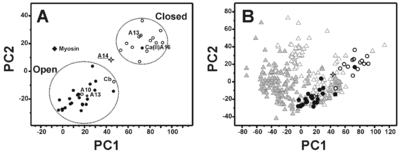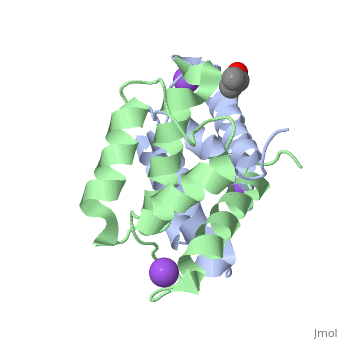Function
S100 proteins are calcium-binding proteins (CBP) found in vertebrates and contain 2 helix-loop-helix calcium binding sites. S100 name is derived from their being 100% soluble in ammonium sulfate. There are at least 21 S100 proteins. Most S100 proteins undergo conformational change upon calcium binding[1].
S100-A1 is a regulator of myocardial contractility.
S100-A2 may have a tumor suppression function.
S100-A4 and S100-A11 may function in motility, invasion and tubulin polymerization.
S100-A6 may function in calcium-dependent insulin release.
S100-A7 is an antimicrobial peptide mainly against E. coli.
S100-A8 combined with S100-A9 (calprotectin) may function in the inhibition of casein kinase and regulate inflammatory processes.
S100-A10 is implicated in the transport of neurotransmitters.
S100-A12 and S100-A13 may function in calcium-dependent signal transduction pathways.
S100-A15 is found in psoriatic skin and functions as antimicrobial peptide.
S100B levels increase in patients suffering from brain damage and are used as diagnostics for traumatic head injury.
S100G is vitamin-D dependent calcium-binding protein and is called calbindin D9k and calbindin D28k depending on its molecular weight. S100G mediates the transport of calcium across enterocytes.
Relevance
S100-A2, S100-A3, S100-A5, S100-A7, S100-A8, S100-A9, S100-A14, S100-A15, S100-A16 and S100-P are over expressed on bladder cancer while S100-A1, S100-A4 and S100-B are under expressed[2]. S100-A12 is the most significant marker for psoriasis disease activity[3]. Various S100 proteins change this expression in skin and sweat glands tumors[4].
Solution structure and dynamics of human S100A14 [5]
Human is a member of the EF-hand calcium-binding protein family that has only recently been described in its functional and pathological properties. The protein is overexpressed in a variety of tumor cells and it has been shown to trigger receptor for advanced glycation end products (RAGE)-dependent signaling in cell cultures. The protein has a high degree of sequence homology with S100A13 although it exhibits a negligible affinity for calcium(II) ions and undergoes aggregation and precipitation in the presence of zinc(II) or copper(II) ions. The lack of two ligands in the canonical EF-hand calcium(II)-binding site explains the negligible affinity for calcium(II) in solution, while the exposed cysteines and histidine account for the observed precipitation in the presence of zinc(II) or copper(II) ions. in S100A13 as well as in other S100 proteins, are mutated in S100A14. The solution structure of (monomer A is in mediumslateblue and monomer B is in deeppink) in the apo state at physiological temperature shows close structural similarities with the C-terminal domain of the myosin light chains and folds in a ‘semi-open’ conformation, with helices III and IV showing a X-shaped offset arrangement and helices II and III showing a high number of interactions creating a V-shaped arrangement.

Principal component analysis performed on the six inter-helical angles of the apo and calcium(II)-loaded forms of S100 proteins. Apo and holo proteins are represented as open and filled circles, respectively. The two open circles not regularly placed with respect to the others correspond to the apo form of calbindin D9k (Cb) and S100A10 (A10). The filled circle placed in the region of protein in closed conformation corresponds to holo S100A16 (A16). S100A14 (open star) is in a ‘semi-open’ conformation in physiological conditions. Apo and holo form of S100A13 are reported as open and closed stars, respectively. Myosin light chain is reported as filled diamond. B). Principal component plot of the whole EFhD dataset derived from principal component analysis of the six inter-helix angles. Apo and holo proteins are represented as open and filled grey triangles, respectively. S100 proteins are reported with the same symbols as in A.
The interacting aromatic residues in stabilize the interhelical orientation
The most remarkable feature of this structural conformation involves the packing of the helices that is reduced with respect to the ‘closed’ structures of the S100 proteins but is still sizably larger than the corresponding ‘open’ structures. At the same time, the analysis of the electrostatic potential surface suggests that the is .
Structural characterization of human S100A16, a low-affinity calcium binder [6]
S100A16 is a special member of the S100 class of calcium binding proteins, because it much smaller than experienced by most S100 proteins. This was observed after determination of the solution structures of apo and and the . The likely reason for minimal conformational change is the lower calcium binding affinity and stronger between with respect to other S100 proteins. Another characteristic of is that the helix IV has the same length in and because of in helix IV. Based on the available structures of S100 members, we analyzed and summarized all their conformational changes due to calcium(II) binding by a principal component analysis. was proved by both NMR titration and Isothermal Titration Calorimetry (ITC) experiments. Even if the in the last position of first EF-hand calcium binding loop , these experimental data indicated that S100A16 can still bind one calcium(II) ion in such loop. NMR relaxation are the most . Although the biological function of S100A16 is still unclear yet, these structural and dynamic properties can provide useful information for further functional studies.
3D Structures of S100 proteins
S100 proteins 3D structures


